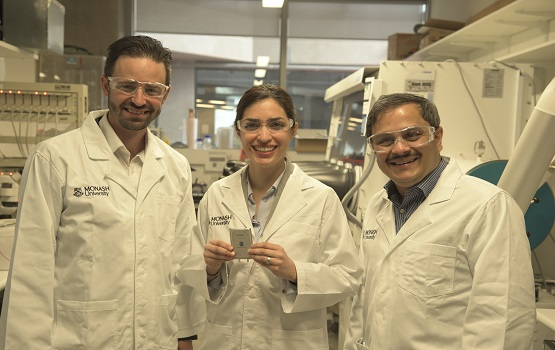Jan 6 2020
A battery that can potentially power smartphones continuously for five days, or allow an electric vehicle to travel over 1000 km without having to “refuel” may seem too good to be true.
 Associate Professor Matthew Hill, Dr Mahdokht Shaibani, and Professor Mainak Majumder with the lithium-sulfur battery design. Image Credit: Monash University.
Associate Professor Matthew Hill, Dr Mahdokht Shaibani, and Professor Mainak Majumder with the lithium-sulfur battery design. Image Credit: Monash University.
Now, scientists at Monash University are on the verge of launching the world’s most efficient lithium-sulfur (Li-S) battery in the market. The Li-S battery has the potential to outpace present market leaders by over four times, and power international markets, including Australia, into the coming days.
Dr Mahdokht Shaibani from the Department of Mechanical and Aerospace Engineering of Monash University headed an international team of researchers that created a novel Li-S battery that has an ultra-high capacity, more improved performance, and minimal environmental impact when compared to existing lithium-ion products.
An approved filed patent (PCT/AU 2019/051239) is available for the scientists’ manufacturing process, and prototype cells have been effectively developed by Fraunhofer Institute for Material and Beam Technology—the German R&D partners.
A few of the world’s top producers of lithium batteries in Europe and China have demonstrated their interest in upscaling the production of Li-S batteries, with additional testing to be conducted in Australia during early 2020.
The study, published in the Science Advances journal on Saturday, January 4th, 2020, is the first-ever Li-S battery research to appear in this prominent international publication.
According to Professor Mainak Majumder, this latest development represents an innovation for the Australian sector and can potentially redefine ways in which solar grids, computers, cars, and phones are developed.
Successful fabrication and implementation of Li-S batteries in cars and grids will capture a more significant part of the estimated $213 billion value chain of Australian lithium, and will revolutionise the Australian vehicle market and provide all Australians with a cleaner and more reliable energy market.
Mainak Majumder, Professor, Monash University
Majumder continued, “Our research team has received more than $2.5 million in funding from government and international industry partners to trial this battery technology in cars and grids from this year, which we’re most excited about.”
The scientists used the same materials in regular lithium-ion batteries to reconfigure the architecture of sulfur cathodes so that they can accommodate greater stress loads, without reducing the overall performance or capacity.
Taking a cue from the exclusive bridging design that was initially recorded in processing detergent powders in the 1970s, the researchers developed a technique that formed bonds between the particles to accommodate stress loads and provides a stability level that has yet to be observed in a battery.
According to Associate Professor Matthew Hill, the latest design of the battery is attractive for upcoming real-world applications due to its excellent performance, ease of processing, lower manufacturing costs, reduced environmental footprint, and abundant supply of material.
This approach not only favours high-performance metrics and long cycle life, but is also simple and extremely low-cost to manufacture, using water-based processes, and can lead to significant reductions in environmentally hazardous waste.
Matthew Hill, Associate Professor, Monash University
The researchers include Dr Mahdokht Shaibani, Dr Meysam Sharifzadeh Mirshekarloo, Dr M.C. Dilusha Cooray, and Professor Mainak Majumder from Monash University; Dr Ruhani Singh, Dr Christopher Easton, Dr Anthony Hollenkamp (CSIRO), and Associate Professor Matthew Hill from CSIRO and Monash University.
Other researchers include Nicolas Eshraghi from the University of Liege; Dr Thomas Abendroth, Dr Susanne Dorfler, Dr Holger Althues, and Professor Stefan Kaskel from the Fraunhofer Institute for Material and Beam Technology.